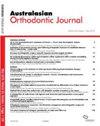To evaluate the rate of canine retraction and pain perception following micro-osteoperforation – a split-mouth clinical study
IF 0.9
4区 医学
Q4 DENTISTRY, ORAL SURGERY & MEDICINE
引用次数: 0
Abstract
Abstract Objective: To evaluate the effectiveness and influence of micro-osteoperforation on the rate of canine retraction and patient pain perception. Method: In this prospective split-mouth clinical trial, forty adult patients in the age range of 15-25 years (18 men and 22 women) requiring bilateral first premolar extraction and upper canine retraction involving maximum anchorage, were enrolled. Two groups of 20 patients each (Group-I and Group-II) were randomly assigned and were further subdivided into subgroups A and B according to the allocation of a maxillary quadrant. Group-I A and Group-II A were the experimental quadrants in which 3 micro-osteoperforations (MOPs) and 2 MOPs were performed, respectively, and Group-I B and Group-II B served as control quadrants. With the help of a mini-screw (1.6 mm diameter, 8 mm length), MOPs were created distal to the maxillary canine following which, canine retraction continued for three months. The collection of data was obtained from monthly plaster models. The primary outcomes were the rate of canine retraction per month and the total distance moved by the canines. The secondary outcomes were to assess patient pain following the MOP procedure. Result: A significant increase in the rate of tooth movement was seen in Group-I A, whereas, in Group II, there was no significant difference in the movement rate between the subgroups A and B. In addition, Group-I A showed a significant increase in the rate of canine retraction compared to Group-II A. The patients did not report significant pain, nor discomfort nor other complications during or after the procedure. Conclusion: Micro-osteoperforation appears to be an effective, comfortable, and safe procedure to accelerate tooth movement and significantly reduce the duration of orthodontic treatment.评估微型整骨术后犬的回缩率和疼痛感知——一项开口临床研究
摘要目的:评价微型骨穿孔对犬回缩率和患者疼痛感觉的影响。方法:在这项前瞻性分口临床试验中,纳入了40名年龄在15-25岁之间的成年患者(18名男性和22名女性),他们需要双侧第一前臼齿拔除和犬上回缩,包括最大限度的锚定。随机分配两组,每组20名患者(第一组和第二组),并根据上颌象限的分配进一步细分为A和B亚组。第一A组和第二A组为实验象限,分别进行3次微骨修复(MOP)和2次MOP,第一B组和第II B组为对照象限。在微型螺钉(直径1.6 mm,长度8 mm)的帮助下,在上颌犬齿远端制作MOP,随后犬齿回缩持续三个月。数据收集是从每月的石膏模型中获得的。主要结果是犬每月的回缩率和犬移动的总距离。次要结果是评估MOP手术后的患者疼痛。结果:在第一A组中,牙齿移动速率显著增加,而在第二组中,A和B亚组之间的移动速率没有显著差异。此外,与第二A组相比,第一A组的犬回缩速率显著增加。患者没有报告显著疼痛,在手术过程中或手术后没有不适或其他并发症。结论:微型整骨术是一种有效、舒适、安全的方法,可以加速牙齿移动,显著缩短正畸治疗的时间。
本文章由计算机程序翻译,如有差异,请以英文原文为准。
求助全文
约1分钟内获得全文
求助全文
来源期刊

Australasian Orthodontic Journal
Dentistry-Orthodontics
CiteScore
0.80
自引率
25.00%
发文量
24
期刊介绍:
The Australasian Orthodontic Journal (AOJ) is the official scientific publication of the Australian Society of Orthodontists.
Previously titled the Australian Orthodontic Journal, the name of the publication was changed in 2017 to provide the region with additional representation because of a substantial increase in the number of submitted overseas'' manuscripts. The volume and issue numbers continue in sequence and only the ISSN numbers have been updated.
The AOJ publishes original research papers, clinical reports, book reviews, abstracts from other journals, and other material which is of interest to orthodontists and is in the interest of their continuing education. It is published twice a year in November and May.
The AOJ is indexed and abstracted by Science Citation Index Expanded (SciSearch) and Journal Citation Reports/Science Edition.
 求助内容:
求助内容: 应助结果提醒方式:
应助结果提醒方式:


